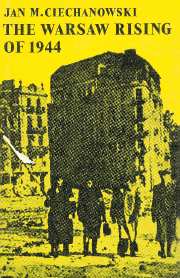Book contents
- Frontmatter
- Contents
- Abbreviations
- Acknowledgements
- Introduction
- Map
- 1 The Big Three and Poland: July 1943–July 1944
- 2 The Genesis of the Polish Resistance Movement
- 3 Attempts to Unify the Polish Resistance Movement
- 4 The Polish Grand Strategy, 1941–1943
- 5 The ‘Tempest’ Plan
- 6 The London Poles and ‘Tempest’
- 7 The ‘Tempest’ East of Warsaw
- 8 The Fate of Warsaw
- 9 Why Warsaw Rose
- 10 Warsaw and the Émigré Leaders
- Conclusions
- Bibliography
- Index
7 - The ‘Tempest’ East of Warsaw
Published online by Cambridge University Press: 04 August 2010
- Frontmatter
- Contents
- Abbreviations
- Acknowledgements
- Introduction
- Map
- 1 The Big Three and Poland: July 1943–July 1944
- 2 The Genesis of the Polish Resistance Movement
- 3 Attempts to Unify the Polish Resistance Movement
- 4 The Polish Grand Strategy, 1941–1943
- 5 The ‘Tempest’ Plan
- 6 The London Poles and ‘Tempest’
- 7 The ‘Tempest’ East of Warsaw
- 8 The Fate of Warsaw
- 9 Why Warsaw Rose
- 10 Warsaw and the Émigré Leaders
- Conclusions
- Bibliography
- Index
Summary
‘Burza’ in Volhynia
In February 1944 Operation ‘Burza’ began in Volhynia – one of the disputed provinces of inter-war Poland, in 1939 incorporated into the U.S.S.R. by the Russians – when a Home Army partisan detachment allegedly of about 6,000 men, began its intensified guerrilla operations against the Germans and the Ukrainian nationalists who collaborated with them. This detachment consisted of most of the Home Army partisan and conspiratorial units in the region. They were grouped together because the Area Commander feared that if they fought as separate units their operations would fail to show any significant results. Further, if they were not organised into one unit they might easily be pulverised by the German punitive counter-measures. Bor-Komorowski approved these tactics.
Thus, even at the initial stage of ‘Burza’, a serious departure was made from the original plan. From the beginning of 1944 ‘Burza’ in Volhynia was planned and executed in the form of relatively large-scale guerrilla operations rather than, as originally outlined by Bor-Komorowski in November 1943, a number of loosely co-ordinated small-scale local attacks on the German rearguards. Within the space of a few months more serious and portentous departures from the ‘Burza’ plan were to be made. It was becoming a highly elastic concept.
In March 1944 the partisan group in Volhynia assumed the name of the 27th Home Army Volhynian Infantry Division, which before the war had been stationed in this region. The assumption of this name was intended to stress the local connections of the unit and to impress on the Russians the fact that they were dealing with a powerful and viable movement, capable of entering the field with strong and well-organised detachments.
- Type
- Chapter
- Information
- The Warsaw Rising of 1944 , pp. 190 - 211Publisher: Cambridge University PressPrint publication year: 1974



